Pacman In Python Code
The Pacman In Python Code is written in Python programming language, This Pacman Game In Python is an arcade game and anyone loves this game.
A Pacman Game Code In Python concept is quite simple. Pacman eats dots in a maze to score points. Avoid the ghosts if you don’t want to game over.
Pacman Game In Python: Project Information
| Project Name: | Pacman Game In Python |
| Language/s Used: | Python (GUI) Based |
| Python version (Recommended): | 2.x or 3.x |
| Database: | None |
| Type: | Python App |
| Developer: | IT SOURCECODE |
| Updates: | 0 |
Anyway, if you want to level up your knowledge in programming especially games in Python, try this new article I’ve made for you Code For Game in Python: Python Game Projects With Source Code.
This Pacman Game Python Code also includes a downloadable Pacman Game Source Code In Python, just find the downloadable source code below and click to start downloading.
To start creating a Pacman In Python Code, make sure that you have PyCharm IDE installed on your computer.
By the way, if you are new to Python programming and don’t know what Python IDE to use, I have here a list of the Best Python IDE for Windows, Linux, and Mac OS that will suit you. I also have here How to Download and Install the Latest Version of Python on Windows.
How to create a Pacman In Python Code
Here are the step-by-step guide on how to create Pacman In Python Code
- Step 1: Create a project name.
First, open Pycharm IDE and then create a “project name” After creating a project name click the “create” button.

- Step 2: Create a python file.
Second, after creating a project name, “right click” your project name and then click “new” After that click the “python file“.

- Step 3: Name your python file.
Third, after creating a Python file, Name your Python file after that click “enter“.

- Step 4. The actual code.
You are free to copy the code given below and download the full source code below.
The Code Given Below Is For The Python File Enemies
import pygame
import random
SCREEN_WIDTH = 800
SCREEN_HEIGHT = 576
# Define some colors
BLACK = (0,0,0)
WHITE = (255,255,255)
BLUE = (0,0,255)
GREEN = (0,255,0)
RED = (255,0,0)
class Block(pygame.sprite.Sprite):
def __init__(self,x,y,color,width,height):
# Call the parent class (Sprite) constructor
pygame.sprite.Sprite.__init__(self)
# Set the background color and set it to be transparent
self.image = pygame.Surface([width,height])
self.image.fill(color)
self.rect = self.image.get_rect()
self.rect.topleft = (x,y)
class Ellipse(pygame.sprite.Sprite):
def __init__(self,x,y,color,width,height):
# Call the parent class (Sprite) constructor
pygame.sprite.Sprite.__init__(self)
# Set the background color and set it to be transparent
self.image = pygame.Surface([width,height])
self.image.fill(BLACK)
self.image.set_colorkey(BLACK)
# Draw the ellipse
pygame.draw.ellipse(self.image,color,[0,0,width,height])
self.rect = self.image.get_rect()
self.rect.topleft = (x,y)
class Slime(pygame.sprite.Sprite):
def __init__(self,x,y,change_x,change_y):
# Call the parent class (Sprite) constructor
pygame.sprite.Sprite.__init__(self)
# Set the direction of the slime
self.change_x = change_x
self.change_y = change_y
# Load image
self.image = pygame.image.load("slime.png").convert_alpha()
self.rect = self.image.get_rect()
self.rect.topleft = (x,y)
def update(self,horizontal_blocks,vertical_blocks):
self.rect.x += self.change_x
self.rect.y += self.change_y
if self.rect.right < 0:
self.rect.left = SCREEN_WIDTH
elif self.rect.left > SCREEN_WIDTH:
self.rect.right = 0
if self.rect.bottom < 0:
self.rect.top = SCREEN_HEIGHT
elif self.rect.top > SCREEN_HEIGHT:
self.rect.bottom = 0
if self.rect.topleft in self.get_intersection_position():
direction = random.choice(("left","right","up","down"))
if direction == "left" and self.change_x == 0:
self.change_x = -2
self.change_y = 0
elif direction == "right" and self.change_x == 0:
self.change_x = 2
self.change_y = 0
elif direction == "up" and self.change_y == 0:
self.change_x = 0
self.change_y = -2
elif direction == "down" and self.change_y == 0:
self.change_x = 0
self.change_y = 2
def get_intersection_position(self):
items = []
for i,row in enumerate(enviroment()):
for j,item in enumerate(row):
if item == 3:
items.append((j*32,i*32))
return items
def enviroment():
grid = ((0,2,0,0,0,0,0,0,0,2,0,0,0,0,0,0,0,2,0,0,0,0,0,2,0),
(0,2,0,0,0,0,0,0,0,2,0,0,0,0,0,0,0,2,0,0,0,0,0,2,0),
(1,3,1,1,1,1,1,1,1,3,1,1,1,1,1,1,1,3,1,1,1,1,1,3,1),
(0,2,0,0,0,0,0,0,0,2,0,0,0,0,0,0,0,2,0,0,0,0,0,2,0),
(0,2,0,0,0,0,0,0,0,2,0,0,0,0,0,0,0,2,0,0,0,0,0,2,0),
(0,2,0,0,0,0,0,0,0,2,0,0,0,0,0,0,0,2,0,0,0,0,0,2,0),
(1,3,1,1,1,1,1,1,1,3,1,1,1,1,1,1,1,3,1,1,1,1,1,3,1),
(0,2,0,0,0,0,0,0,0,2,0,0,0,0,0,0,0,2,0,0,0,0,0,2,0),
(0,2,0,0,0,0,0,0,0,2,0,0,0,0,0,0,0,2,0,0,0,0,0,2,0),
(0,2,0,0,0,0,0,0,0,2,0,0,0,0,0,0,0,2,0,0,0,0,0,2,0),
(1,3,1,1,1,1,1,1,1,3,1,1,1,1,1,1,1,3,1,1,1,1,1,3,1),
(0,2,0,0,0,0,0,0,0,2,0,0,0,0,0,0,0,2,0,0,0,0,0,2,0),
(0,2,0,0,0,0,0,0,0,2,0,0,0,0,0,0,0,2,0,0,0,0,0,2,0),
(0,2,0,0,0,0,0,0,0,2,0,0,0,0,0,0,0,2,0,0,0,0,0,2,0),
(1,3,1,1,1,1,1,1,1,3,1,1,1,1,1,1,1,3,1,1,1,1,1,3,1),
(0,2,0,0,0,0,0,0,0,2,0,0,0,0,0,0,0,2,0,0,0,0,0,2,0),
(0,2,0,0,0,0,0,0,0,2,0,0,0,0,0,0,0,2,0,0,0,0,0,2,0),
(0,2,0,0,0,0,0,0,0,2,0,0,0,0,0,0,0,2,0,0,0,0,0,2,0))
return grid
def draw_enviroment(screen):
for i,row in enumerate(enviroment()):
for j,item in enumerate(row):
if item == 1:
pygame.draw.line(screen, BLUE , [j*32, i*32], [j*32+32,i*32], 3)
pygame.draw.line(screen, BLUE , [j*32, i*32+32], [j*32+32,i*32+32], 3)
elif item == 2:
pygame.draw.line(screen, BLUE , [j*32, i*32], [j*32,i*32+32], 3)
pygame.draw.line(screen, BLUE , [j*32+32, i*32], [j*32+32,i*32+32], 3)
The code given is the python file enemies which shows the different colors of ghost enemies that you want to avoid.
The Code Given Below Is For The Python File Game
import pygame
from player import Player
from enemies import *
import tkinter
from tkinter import messagebox
SCREEN_WIDTH = 800
SCREEN_HEIGHT = 576
# Define some colors
BLACK = (0,0,0)
WHITE = (255,255,255)
BLUE = (0,0,255)
RED = (255,0,0)
class Game(object):
def __init__(self):
self.font = pygame.font.Font(None,40)
self.about = False
self.game_over = True
# Create the variable for the score
self.score = 0
# Create the font for displaying the score on the screen
self.font = pygame.font.Font(None,35)
# Create the menu of the game
self.menu = Menu(("Start","About","Exit"),font_color = WHITE,font_size=60)
# Create the player
self.player = Player(32,128,"player.png")
# Create the blocks that will set the paths where the player can go
self.horizontal_blocks = pygame.sprite.Group()
self.vertical_blocks = pygame.sprite.Group()
# Create a group for the dots on the screen
self.dots_group = pygame.sprite.Group()
# Set the enviroment:
for i,row in enumerate(enviroment()):
for j,item in enumerate(row):
if item == 1:
self.horizontal_blocks.add(Block(j*32+8,i*32+8,BLACK,16,16))
elif item == 2:
self.vertical_blocks.add(Block(j*32+8,i*32+8,BLACK,16,16))
# Create the enemies
self.enemies = pygame.sprite.Group()
self.enemies.add(Slime(288,96,0,2))
self.enemies.add(Slime(288,320,0,-2))
self.enemies.add(Slime(544,128,0,2))
self.enemies.add(Slime(32,224,0,2))
self.enemies.add(Slime(160,64,2,0))
self.enemies.add(Slime(448,64,-2,0))
self.enemies.add(Slime(640,448,2,0))
self.enemies.add(Slime(448,320,2,0))
# Add the dots inside the game
for i, row in enumerate(enviroment()):
for j, item in enumerate(row):
if item != 0:
self.dots_group.add(Ellipse(j*32+12,i*32+12,WHITE,8,8))
# Load the sound effects
self.pacman_sound = pygame.mixer.Sound("pacman_sound.ogg")
self.game_over_sound = pygame.mixer.Sound("game_over_sound.ogg")
def process_events(self):
for event in pygame.event.get(): # User did something
if event.type == pygame.QUIT: # If user clicked close
return True
self.menu.event_handler(event)
if event.type == pygame.KEYDOWN:
if event.key == pygame.K_RETURN:
if self.game_over and not self.about:
if self.menu.state == 0:
# ---- START ------
self.__init__()
self.game_over = False
elif self.menu.state == 1:
# --- ABOUT ------
self.about = True
elif self.menu.state == 2:
# --- EXIT -------
# User clicked exit
return True
elif event.key == pygame.K_RIGHT:
self.player.move_right()
elif event.key == pygame.K_LEFT:
self.player.move_left()
elif event.key == pygame.K_UP:
self.player.move_up()
elif event.key == pygame.K_DOWN:
self.player.move_down()
elif event.key == pygame.K_ESCAPE:
self.game_over = True
self.about = False
elif event.type == pygame.KEYUP:
if event.key == pygame.K_RIGHT:
self.player.stop_move_right()
elif event.key == pygame.K_LEFT:
self.player.stop_move_left()
elif event.key == pygame.K_UP:
self.player.stop_move_up()
elif event.key == pygame.K_DOWN:
self.player.stop_move_down()
elif event.type == pygame.MOUSEBUTTONDOWN:
self.player.explosion = True
return False
def run_logic(self):
if not self.game_over:
self.player.update(self.horizontal_blocks,self.vertical_blocks)
block_hit_list = pygame.sprite.spritecollide(self.player,self.dots_group,True)
# When the block_hit_list contains one sprite that means that player hit a dot
if len(block_hit_list) > 0:
# Here will be the sound effect
self.pacman_sound.play()
self.score += 1
block_hit_list = pygame.sprite.spritecollide(self.player,self.enemies,True)
if len(block_hit_list) > 0:
self.player.explosion = True
self.game_over_sound.play()
self.game_over = self.player.game_over
self.enemies.update(self.horizontal_blocks,self.vertical_blocks)
# tkMessageBox.showinfo("GAME OVER!","Final Score = "+(str)(GAME.score))
def display_frame(self,screen):
# First, clear the screen to white. Don't put other drawing commands
screen.fill(BLACK)
# --- Drawing code should go here
if self.game_over:
if self.about:
self.display_message(screen,"It is an arcade Game")
#"a maze containing various dots,\n"
#known as Pac-Dots, and four ghosts.\n"
#"The four ghosts roam the maze, trying to kill Pac-Man.\n"
#"If any of the ghosts hit Pac-Man, he loses a life;\n"
#"the game is over.\n")
else:
self.menu.display_frame(screen)
else:
# --- Draw the game here ---
self.horizontal_blocks.draw(screen)
self.vertical_blocks.draw(screen)
draw_enviroment(screen)
self.dots_group.draw(screen)
self.enemies.draw(screen)
screen.blit(self.player.image,self.player.rect)
#text=self.font.render("Score: "+(str)(self.score), 1,self.RED)
#screen.blit(text, (30, 650))
# Render the text for the score
text = self.font.render("Score: " + str(self.score),True,GREEN)
# Put the text on the screen
screen.blit(text,[120,20])
# --- Go ahead and update the screen with what we've drawn.
pygame.display.flip()
def display_message(self,screen,message,color=(255,0,0)):
label = self.font.render(message,True,color)
# Get the width and height of the label
width = label.get_width()
height = label.get_height()
# Determine the position of the label
posX = (SCREEN_WIDTH /2) - (width /2)
posY = (SCREEN_HEIGHT /2) - (height /2)
# Draw the label onto the screen
screen.blit(label,(posX,posY))
class Menu(object):
state = 0
def __init__(self,items,font_color=(0,0,0),select_color=(255,0,0),ttf_font=None,font_size=25):
self.font_color = font_color
self.select_color = select_color
self.items = items
self.font = pygame.font.Font(ttf_font,font_size)
def display_frame(self,screen):
for index, item in enumerate(self.items):
if self.state == index:
label = self.font.render(item,True,self.select_color)
else:
label = self.font.render(item,True,self.font_color)
width = label.get_width()
height = label.get_height()
posX = (SCREEN_WIDTH /2) - (width /2)
# t_h: total height of text block
t_h = len(self.items) * height
posY = (SCREEN_HEIGHT /2) - (t_h /2) + (index * height)
screen.blit(label,(posX,posY))
def event_handler(self,event):
if event.type == pygame.KEYDOWN:
if event.key == pygame.K_UP:
if self.state > 0:
self.state -= 1
elif event.key == pygame.K_DOWN:
if self.state < len(self.items) -1:
self.state += 1
The code given is the Python file game which is in this python file have many function modules.
The Code Given Below Is For The Python File Player
import pygame
SCREEN_WIDTH = 800
SCREEN_HEIGHT = 576
# Define some colors
BLACK = (0,0,0)
WHITE = (255,255,255)
class Player(pygame.sprite.Sprite):
change_x = 0
change_y = 0
explosion = False
game_over = False
def __init__(self,x,y,filename):
# Call the parent class (sprite) constructor
pygame.sprite.Sprite.__init__(self)
self.image = pygame.image.load(filename).convert()
self.image.set_colorkey(BLACK)
self.rect = self.image.get_rect()
self.rect.topleft = (x,y)
# Load image which will be for the animation
img = pygame.image.load("walk.png").convert()
# Create the animations objects
self.move_right_animation = Animation(img,32,32)
self.move_left_animation = Animation(pygame.transform.flip(img,True,False),32,32)
self.move_up_animation = Animation(pygame.transform.rotate(img,90),32,32)
self.move_down_animation = Animation(pygame.transform.rotate(img,270),32,32)
# Load explosion image
img = pygame.image.load("explosion.png").convert()
self.explosion_animation = Animation(img,30,30)
# Save the player image
self.player_image = pygame.image.load(filename).convert()
self.player_image.set_colorkey(BLACK)
def update(self,horizontal_blocks,vertical_blocks):
if not self.explosion:
if self.rect.right < 0:
self.rect.left = SCREEN_WIDTH
elif self.rect.left > SCREEN_WIDTH:
self.rect.right = 0
if self.rect.bottom < 0:
self.rect.top = SCREEN_HEIGHT
elif self.rect.top > SCREEN_HEIGHT:
self.rect.bottom = 0
self.rect.x += self.change_x
self.rect.y += self.change_y
# This will stop the user for go up or down when it is inside of the box
for block in pygame.sprite.spritecollide(self,horizontal_blocks,False):
self.rect.centery = block.rect.centery
self.change_y = 0
for block in pygame.sprite.spritecollide(self,vertical_blocks,False):
self.rect.centerx = block.rect.centerx
self.change_x = 0
# This will cause the animation to start
if self.change_x > 0:
self.move_right_animation.update(10)
self.image = self.move_right_animation.get_current_image()
elif self.change_x < 0:
self.move_left_animation.update(10)
self.image = self.move_left_animation.get_current_image()
if self.change_y > 0:
self.move_down_animation.update(10)
self.image = self.move_down_animation.get_current_image()
elif self.change_y < 0:
self.move_up_animation.update(10)
self.image = self.move_up_animation.get_current_image()
else:
if self.explosion_animation.index == self.explosion_animation.get_length() -1:
pygame.time.wait(500)
self.game_over = True
self.explosion_animation.update(12)
self.image = self.explosion_animation.get_current_image()
def move_right(self):
self.change_x = 3
def move_left(self):
self.change_x = -3
def move_up(self):
self.change_y = -3
def move_down(self):
self.change_y = 3
def stop_move_right(self):
if self.change_x != 0:
self.image = self.player_image
self.change_x = 0
def stop_move_left(self):
if self.change_x != 0:
self.image = pygame.transform.flip(self.player_image,True,False)
self.change_x = 0
def stop_move_up(self):
if self.change_y != 0:
self.image = pygame.transform.rotate(self.player_image,90)
self.change_y = 0
def stop_move_down(self):
if self.change_y != 0:
self.image = pygame.transform.rotate(self.player_image,270)
self.change_y = 0
class Animation(object):
def __init__(self,img,width,height):
# Load the sprite sheet
self.sprite_sheet = img
# Create a list to store the images
self.image_list = []
self.load_images(width,height)
# Create a variable which will hold the current image of the list
self.index = 0
# Create a variable that will hold the time
self.clock = 1
def load_images(self,width,height):
# Go through every single image in the sprite sheet
for y in range(0,self.sprite_sheet.get_height(),height):
for x in range(0,self.sprite_sheet.get_width(),width):
# load images into a list
img = self.get_image(x,y,width,height)
self.image_list.append(img)
def get_image(self,x,y,width,height):
# Create a new blank image
image = pygame.Surface([width,height]).convert()
# Copy the sprite from the large sheet onto the smaller
image.blit(self.sprite_sheet,(0,0),(x,y,width,height))
# Assuming black works as the transparent color
image.set_colorkey((0,0,0))
# Return the image
return image
def get_current_image(self):
return self.image_list[self.index]
def get_length(self):
return len(self.image_list)
def update(self,fps=30):
step = 30 // fps
l = range(1,30,step)
if self.clock == 30:
self.clock = 1
else:
self.clock += 1
if self.clock in l:
# Increase index
self.index += 1
if self.index == len(self.image_list):
self.index = 0
The code given is the Python file player that can manage the game.
The Code Given Below Is For The Python File Main
import pygame
from game import Game
SCREEN_WIDTH = 800
SCREEN_HEIGHT = 576
def main():
# Initialize all imported pygame modules
pygame.init()
# Set the width and height of the screen [width, height]
screen = pygame.display.set_mode((SCREEN_WIDTH,SCREEN_HEIGHT))
# Set the current window caption
pygame.display.set_caption("PACMAN")
#Loop until the user clicks the close button.
done = False
# Used to manage how fast the screen updates
clock = pygame.time.Clock()
# Create a game object
game = Game()
# -------- Main Program Loop -----------
while not done:
# --- Process events (keystrokes, mouse clicks, etc)
done = game.process_events()
# --- Game logic should go here
game.run_logic()
# --- Draw the current frame
game.display_frame(screen)
# --- Limit to 30 frames per second
clock.tick(30)
#tkMessageBox.showinfo("GAME OVER!","Final Score = "+(str)(GAME.score))
# Close the window and quit.
# If you forget this line, the program will 'hang'
# on exit if running from IDLE.
pygame.quit()
if __name__ == '__main__':
main()
The code given is the Python file main which is in this Python file connected to all the given Python files.
Output:
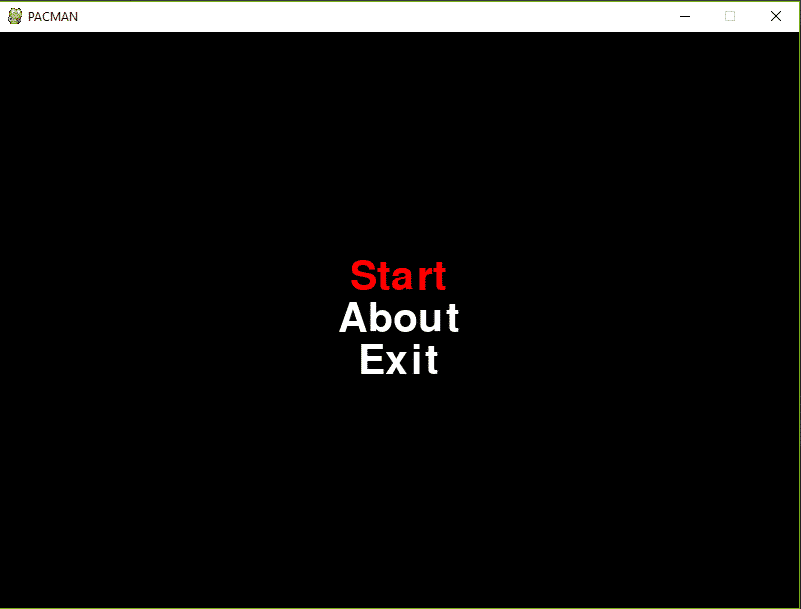
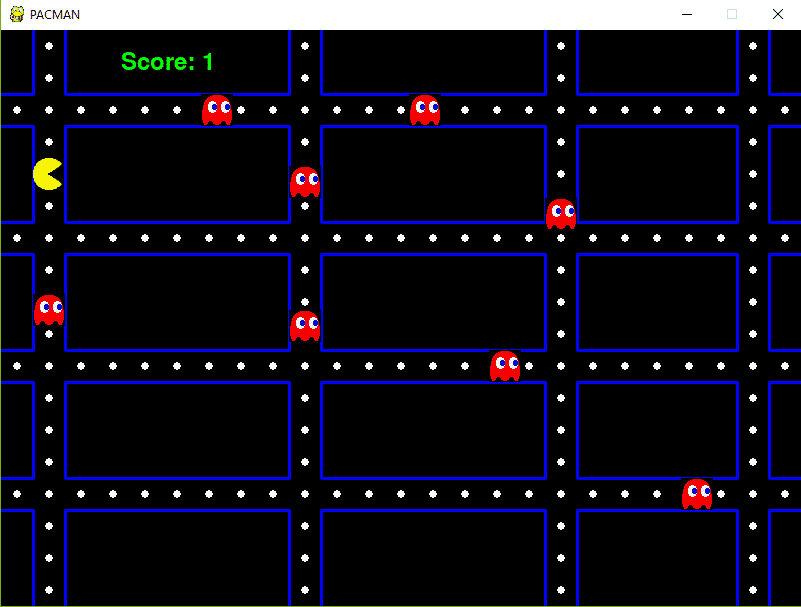
Downloadable Source Code
I have here the list of Best Python Projects with Source code free to download for free, I hope this can help you a lot.
Summary
The Pacman Code In Python is written in Python programming language, Python is very smooth to research the syntax emphasizes readability and it is able to reduce time ingesting in developing.
Also, this tutorial is the simplest way for beginners or students to enhance their logical skills in programming. This game project is a way for students or beginners to design and develop games.
Related Articles
- Snakes and Ladders Game in Python with Source Code
- Code For Game in Python: Python Game Projects With Source Code
- Stickman Game in Python with Source Code
- Tank Game Python with Source Code
- Tetris In Python Code
Inquiries
If you have any questions or suggestions about Pacman Code In Python, please feel free to leave a comment below.


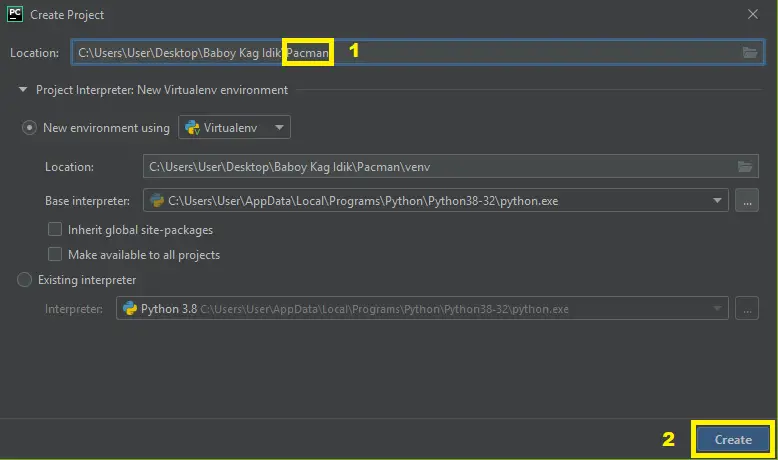
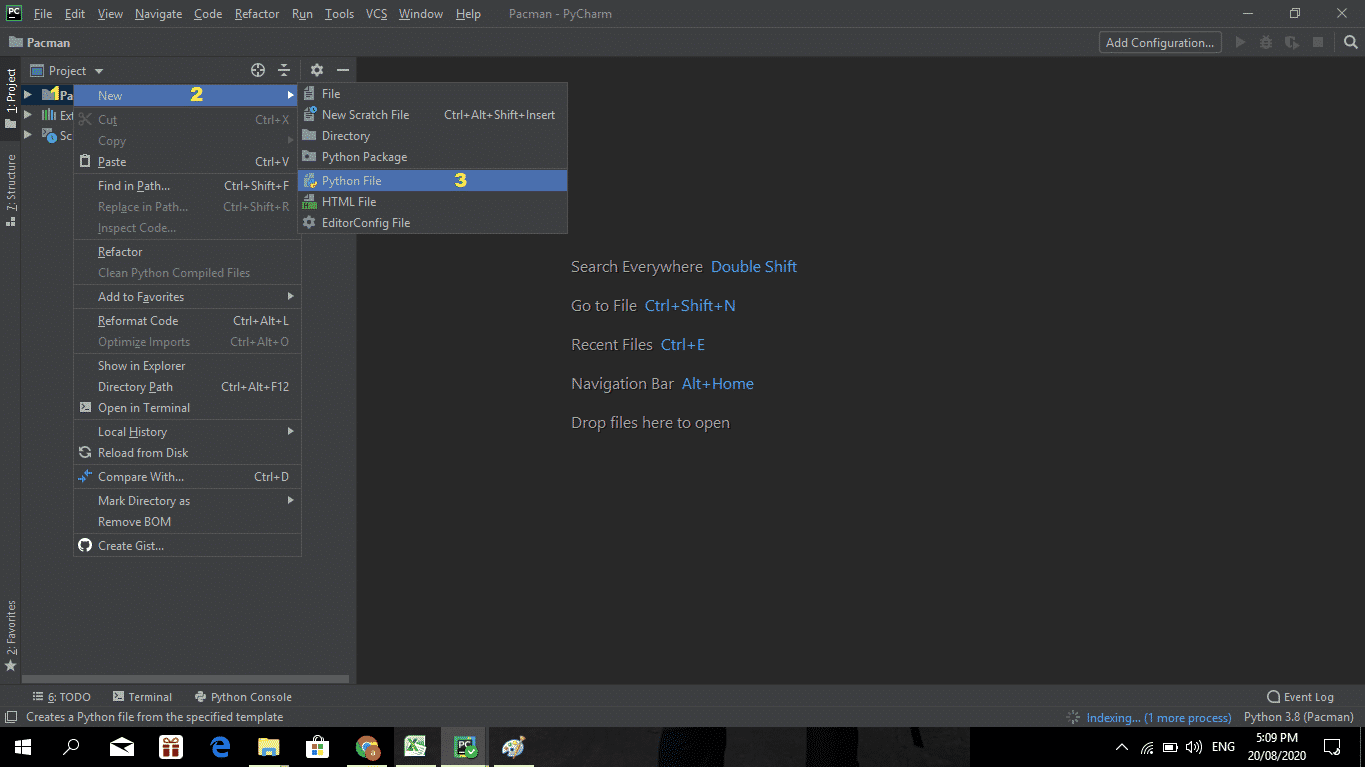
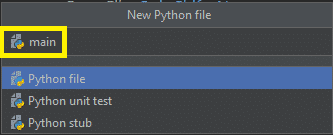
What if I want to add the levels to the game?
If you want to add levels. Its alright you can change it
But how can I implement it as a code?
What would be the easiest way to have various coloured ghosts?